Navigation: Alers Hankey > Miss Alers > William Alers > John Alers > Jameson Alers >
1873-1940
Sydney Alers Hankey (Syd) was born in 1873 at Bromley, Kent, the fifth son and ninth child of Jameson Alers Hankey and his wife Minna Louisa nee Lyons. He was baptised on 16 Mar 1873 at Leamington Priors.
Syd was married three times.
Died of pneumonia on 17 Sep 1940 at Cavtat, Yugoslavia
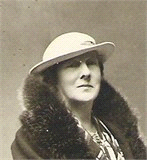
-Firstly in 1895 to Kathleen May Summers; divorced 1904. They had one daughter Helen Dorothy (1898-1981), who was married to Alfred Newnham Turner; they lived in South Africa and had one daughter.
-Secondly in 1905 to Theodosia Abdy (divorced in 1922). They had one son Richard Lyons Alers Hankey, CB (1906-1969), a principal solicitor at HM Treasury (he married Lavender Barr in 1937, and had one son Andrew Richard Alers Hankey (b 1939); Andrew married Hannah Pilzer in 1968 and they have two daughters).
-Thirdly to Phillis Crawley; they had one daughter Judy (b 1928 in Zara, Dalmatia), who was twice married and lives in the United States.
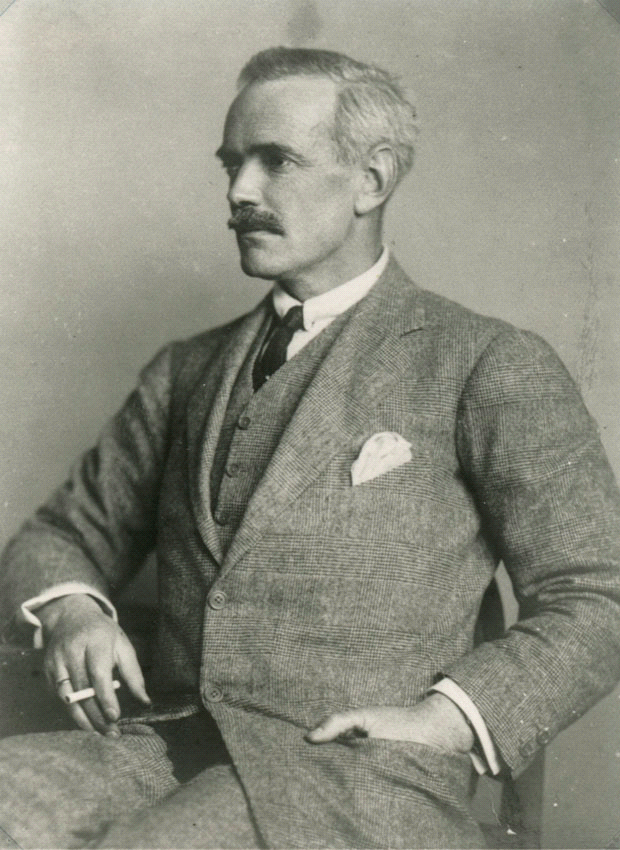
Sydney Alers Hankey
Sydney’s first marriage was in Sydney, Australia, in 1895, when he gave his occupation as Tea Planter. His daughter Helen was born at Doornfontein, South Africa in 1898. Sydney worked for a bank and spent some time in Egypt. He later worked in Danzig and retired to Villa Rita, Bareagno, Zara in Dalmatia (then part of Italy and now named Zadar in Yugoslavia). He escaped from Zara when the Italians entered the war, but died of pneumonia on 17 Sep 1940 at Cavtat, Yugoslavia. Phillis managed to reach Baghdad and finally Canada, and later lived in the United States.
The following narrative was largely compiled by Syd’s grandson Andrew Alers Hankey from the recollections of Syd’s daughter Judy Coppola. It deals mainly with Judy’s early life at the family home in Zara, followed by their eviction from Zara in June 1940 after Mussolini’s declaration of war, when Judy was 12 years old, and Syd’s death from pneumonia three months later on 17 Sep 1940 in Cavtat, Yugoslavia. The subsequent account is of the extraordinary journey of Phillis and Judy to Los Angeles and finally to Canada, all over a period of about 9 months. Additional information is taken from a letter, part of which survives, written by Judy’s mother Phillis probably to Syd’s brother Humphrey in South Africa.
Syd had retired to Zara in Dalmatia. Zara, now called Zadar, was one of a number of Italian enclaves (towns surrounded by Yugoslavian territory complete with frontier posts) along the coast of Yugoslavia and is half way between Trieste and Dubrovnik.
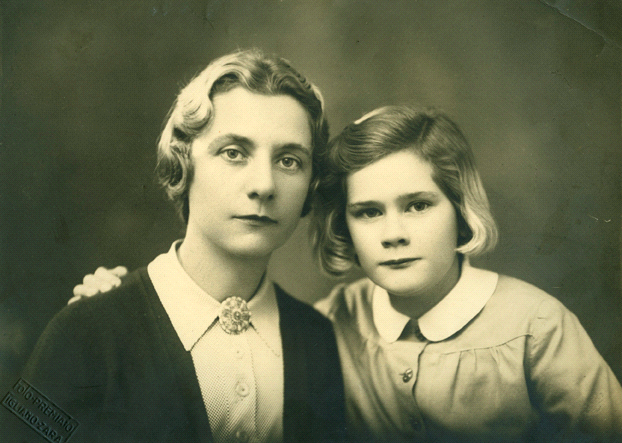
Phillis and Judy circa 1937
Judy’s Recollections
My knowledge of SAH’s early years goes back only as far as his time in the Boer War which he never talked about. This could account for his later presence in Egypt, where his son Richard was born in 1906. He worked there for some time with a bank (probably Barclays DCO) and later with the British Trade Corporation in Danzig. My father had much correspondence with people in Egypt and I used to send him letters to an address at Sharia Antikana. Nothing was ever said about his second wife Theodosia, and certainly his first wife, May, was a real surprise to me. I don’t know when SAH and Phillis moved to Villa Rita, probably from Danzig, but certainly before I was born in 1928.
At Villa Rita, we entertained a lot of the Hankey brothers during the summer [this must have been in the mid-1930’s], including Humphrey who was a silver fox type. I seem to recall Tim, Algy and his wife Edith, Hugh Boustead, Gerald, and of course SAH’s son Richard. Nothing was ever said about the grandparents, Jameson and Minna, but many photos of Jameson’s yachts lined the inner wall of the staircase, which made going up and downstairs interesting for me!
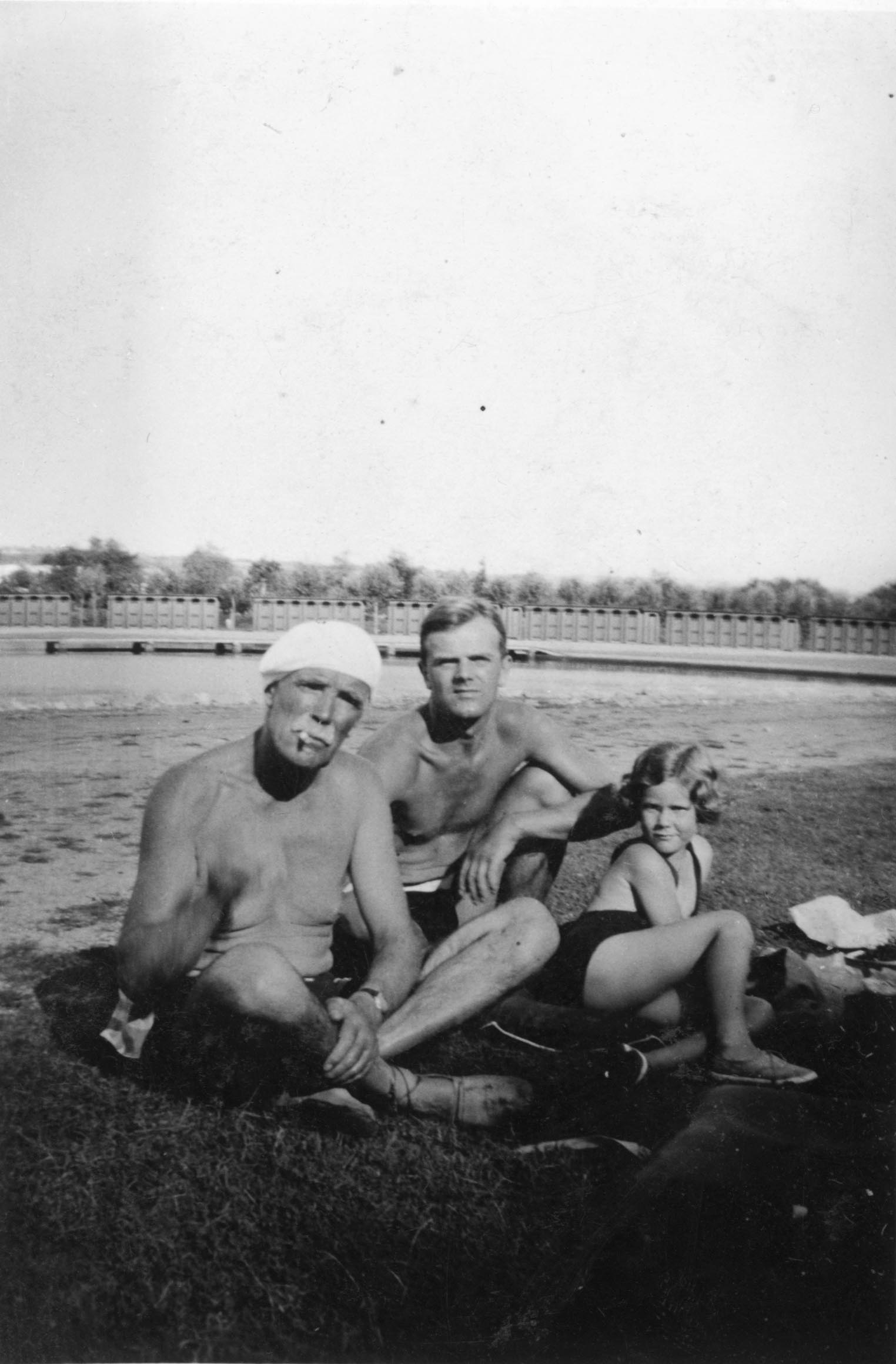
SAH, Richard and Judy mid-1930s
SAH was an embarrassment for me - his outré outfits, the Turkish sandals, the kimono on his way to a swim, the black beret (because of baldness presumably) and the nude sunbathing. One year, while chopping wood, a chip flew into his scalp starting a major infection. Dr. Portada (Vienna trained) would come to the house daily to dress the incisions. (No antibiotics then, just quarts of peroxide poured into the trench-like wounds causing much foaming and moans from SAH).
Georg von Trapp was best buddies with SAH and a frequent guest at our house. He was born in Zara of an Austrian father and English mother, and had a distinguished career in the Austro-Hungarian navy as a submariner. They rented a house further along the winding seafront road in front of Villa Rita and he had a sea-worthy yacht named the Alba Maris. He and SAH often proposed to take it to distant destinations (SAH sailed, we had a small boat, the Zaratino, with which we would visit the Croatian islands that we could see in the distance.) All the kids from both the first and second wife (Sound of Music a joke) were there and they actually wore classic Austrian costume (‘tracht’). I have a family group photo, framed and inscribed to mother which also includes a small photo of Gusterl (diminutive) and Georg and one of me as a little kid sitting with the Baron at a small table in front of the huge palm trees in front of Villa Rita. Georg was a very religious Catholic and really liked his food. I recall him wolfing down the house’s famous salata srbska. He was also a real sweetie to a little kid like me. [In 1938 SAH arranged for his brother Humphrey and family to meet Baron von Trapp at his estate in Austria. The party drove from Munich to Salzburg on 12 March 1938, the day of the Anchluss, and were sourrounded by German military vehicles as they drove down the autobahn, and saw the frontier post being broken up as they entered Austria.]
SAH had many absences from the house because he loved warm climates. I sensed that there was much tension between mother and him. He once went to the South Pacific. I remember Papeete, during which time he made the Australian papers because he had recently gone through the Panama Canal in one of those canvas and rubber faltbots (German) which he also owned in Zara. Unfortunately, for me, he brought back two sarongs, one red and one green, which he often wore while hanging around the water or generally lounging! During the Abyssinian war (with Mussolini) we went to England to get away from the anti-British sentiments and again he took off.
So it was mother and me first at my grandmother’s in West Acton and then at East Horsley and then Hugh Boustead’s wonderful 16th century cottage in Effingham. Before SAH left, we took a trip to Danzig so he could visit his old partner from the British Trade Corporation - this was before Zara. He and mother met in London through work, and he took her along to work for him in Danzig. I have no idea if there were also financial things to settle there but I loved the trip by Polish boat through the Kiel canal and the fact that the Ranns had a great Alsatian dog, named Hassan, who was so amazing that they let him take me for walks unattended by any human!!
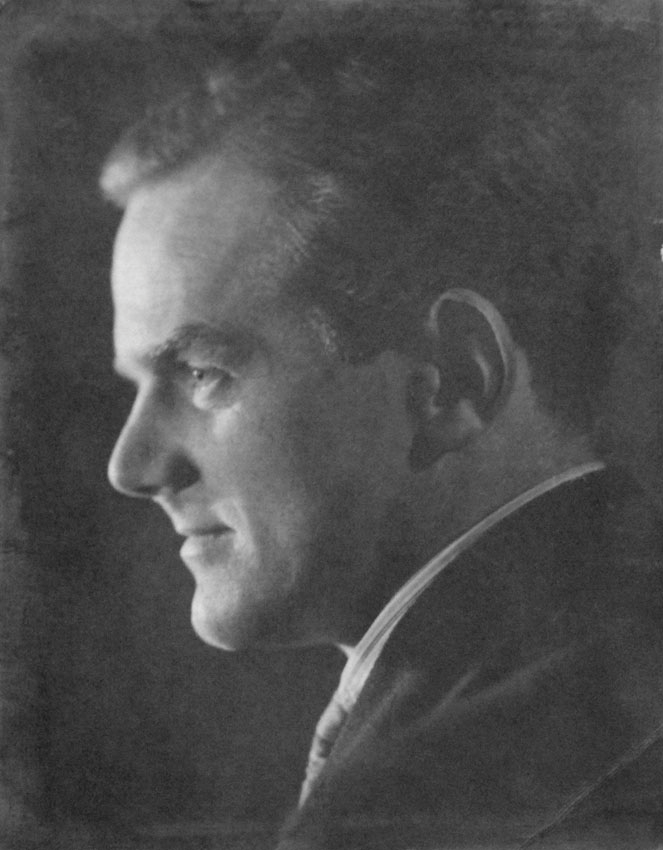
Richard Alers Hankey
Presumably because of SAH’s roaming he was very good with languages: French, German, some Arabic and Polish; in fact every morning at Villa Rita I was roped into about two hours of language instruction. His text was All Quiet on the Western Front in both French and German (A l’ouest rien de nouveau and Am westerns nicht neues). Whenever I failed to recognize a word it would get marked so that I would be re-tested on it. Many mornings I sat there longing to be out swimming. He was an avid reader and we had subscriptions to magazines such as Punch, which I liked, and Blackwoods, which I did not. He also liked to listen to the radio tuned into stations all over Europe - Bratislava, anyone?
I wish now that my father had not been so un-forthcoming; his life was very interesting, obviously, and represents what upper middle class life was like in the last quarter of the 19th century and into the 20th. Most of the brothers apparently couldn’t wait to get out of England - true of Jameson too.
Eviction from Zara, Death of SAH and Voyage to North America in 1940-1941
Back in Zara, SAH stuck it out to the last possible minute. An almost daily guest in our house, bearing gifts, flowers, etc. was an American yachtsman named Fred. J Schussel (‘FJS’), once a U.S. Consul, wealthy and a talented marine and domestic architect. We listened to Mussolini’s declaration of war on the radio, in June 1940 - I can still quote from it. Next day the Carabinieri gave us 24 hours to leave. The plan was to catch the Morosini (Lloyd Triestina) and go to Dubrovnik. We, including FJS, after hasty packing, went to the Riva & Dogana to await the ship, which finally arrived, very late, past 1 a.m. At the top of the gangplank, the authorities relieved SAH of every bit of money, Dinars and cheque books, he had. Earlier, Mother had slit open the back of a Disney Dopey doll (a Snow White and the Seven Dwarfs novelty) and stitched into it some sort of cheque or letter of credit drawn on the Swiss Bank, Societe de Banque Suisse.
I was assigned the job of conspicuously carrying Dopey and looking like an innocent kid - successfully done. I was also lugging my beloved bike. With no money we were forced to disembark and return to Villa Rita before they had officially sealed it. My mother’s devoted and beloved housekeeper, Angelina and husband Giovanni, in the meantime went looking for alternative means of departure. The Morosini was the last major ship to enter and leave the harbour before the submarine net was lowered. One of the Croatian fishing boats (a motor sailer) was located and we were able to pile on to that, headed for the island of Preko in, so far, neutral territory. It was the day Paris fell. (I can also tell you where I was the day Stalin invaded the Baltic States & where I was the day Barcelona fell to Franco - we got a day off school to celebrate!)
After a day or so we caught a small Jadranska ship to Dubrovnik - all on FJS’s dime. We arrived there quite broke (no bank was interested in the S de B S check) but we located a guest house thanks to FJS. Somehow we were told that in Cavtat, about 36 - 40 minutes away by water [just south of Dubrovnik], there was an American family living and it was decided to head there. We found a house up on a hill - very primitive - no proper plumbing. Contact was made with the U.S. Elias family who lived in a slightly converted wing of a Franciscan monastery. They had a son and daughter around my age and we became firm friends - to this day.
FJS briefly got back to Zara (the U.S. not yet in the war) to arrange for the yacht Columbia to be taken to dry dock in Fiume (now Rijeka) [a port just south of Trieste] by his one-man crew, Mirko. So, for a while (we were in Cavtat for 4 - 5 months altogether) life settled into a routine of swimming & leisure & socialising with the Elias’s. SAH got friendly with a strange ex-pat Dutch woman, Alma Brant-Bouyes, who taught me how knit lace! God knows what was going on in the minds of the adults - it was a strange menage-a-trois. FJS, mother and Dick Elias even went on a fishing trip on his (FJS) new boat - much, much smaller than Columbia. In the meantime war clouds were coming closer and I see from old correspondence that SAH was being warned by the Consulate that British subjects should think about leaving.
Around then SAH became ill [with pneumonia]. I wasn’t around too much but his last words to me were ‘poor old daddy, ready for the rubbish heap’. He was buried in a little cemetery at the top of a hill which I had the good fortune to see again when I was there in the late 90’s. There is no marker, but I remembered that his slot was next to that of a military officer from some previous war. You know the custom of always having a photo on the gravestone, so when I was there I could pick out the space (the photo of the officer had since been defaced by some partisan hater, but was still recognizable). At the time, Marilyn Elias and I were recruited to pick a vast amount of a kind of heather and that was made into a cover for the coffin. The local populace thought he had committed suicide and a German speaker even said to my mother ‘I congratulate you madame’! He wasn’t ill long - minimal to no medical care. I have the original Serbo-Croatian death certificate and cause of death in Latin! He was 67.
So Mother and FJS began to deal with the ‘where to go’ question. Uncle Humphrey [one of SAH’s brothers] in South Africa was considered (he had loaned us money) but disregarded because at that time the Germans looked as though they would soon be occupying all of Africa - it was also considered to be a dangerous trip! So the destination of choice was Uncle Gerald [another of SAH’s brothers] in Vernon B.C., Canada. The U.K. Consulates were permitted to advance funds to British subjects to get to safety and report to Belgrade. The three of us arrived there by train. I stayed with the grand-daughter of the late prime minister of Yugoslavia, Nikolas Pacic. I had met her in Cavtat where they had a summer home (now an hotel). We left Belgrade railroad station at night. On the platform we met a huge Englishman, name of Leslie W. Prehn, who was finding his way out of the USSR. He joined us and bunked with FJS.
[From the letter from Phillis - We arrived in Belgrade to hear the journey was to proceed to Constantinople, Baghdad, Basrah and then India where it was to stop. If you had help to proceed further, lucky you, otherwise one was to be given work in India for one’s food and lodging. Well, I discussed the matter with various awfully nice people at the Legations etc., and they all strongly advised me if at all possible to make Canada my goal. South Africa was not considered so safe.]
What a motley crew! I was still young enough to find it an adventurous situation. I asked no questions, and pretty much no explanations were really given. We crossed the Greek and Bulgarian borders - war was being waged in the Greek section and eventually approached Istanbul in early a.m. It was a beautiful sight. The domes and minarets were poking through the pinkish mist and I promptly fell in love with Turkey. We landed at the old railroad station (now abandoned) and stayed at the Hotel Novotny in Bayoglu. The days were spent reporting to embassies, getting money and visas. The hardest was the Syrian - then under Vichy French control. Finally got one ’Pour Transit sans arête’. We were heading to Baghdad where we hoped to find passage on a ship from Basrah to CA. After about a week we crossed over to Asia to catch the Taurus Express to Baghdad. We reached Aleppo, Syria, in the middle of the night and had to change trains amid wild confusion (Prehn still along). The new train had rattan seats and several compartments contained opulently clad sheiks complete with their weapons. A Latvian refugee shared a tin of sardines with us - why do I remember his name - Mr Atlas.
On arrival, the four of us checked into the Semirames Hotel in Al-Rashid Street and backing onto the Tigris. Baghdad was still wild and woolly - donkeys on the sidewalk, smoky air, pushing and shoving, men carrying huge loads on their backs secured by cloth bands around their heads so that they were almost bent double. The Khadhamain Mosque, its gold dome very impressive. The ship offices were in a tiny alley, and it looked like we could leave on the Blumfontein - date uncertain. At the Eastern Bank we met John Norman a British bank official who took up with us. We travelled to Babylon, the famous Arch of Ctesiphon (the U.S. told the troops not to touch it post invasion). I remember one evening at Norman’s house (Xmas ?) when all the adults got somewhat sloshed and were laughing uproariously and being quite silly. I looked on in amazement - never saw my mother behave like that. She was not a demonstrative person and really did not reveal much about herself, her life or feelings. Most of the time I would only infer, and if I questioned her, did not get very far.
Anyway - our stay in Baghdad continued, and when we were told the Blumfontein was full (Java Pacific - a Dutch Line), we were listed for the Boschfontein in January. On Xmas we went to an Anglican church - I remember the sky being an incredibly intense blue and the sun brilliant - a very Mid-Eastern feeling. Tobruk fell to the Germans (Rommel) in North Africa around that time and things looked very grim.
[From the letter from Phillis - When we were in Baghdad I at once thought of the steamer leaving Basrah for America (a Dutch steamer) and thought that might be the way out. It was, but it meant waiting in Baghdad six weeks for accommodation. To my utter delight our good American friend said if he could also get a passage, he would go to America that way instead of going to Lisbon. After agonising ups and downs, it was all arranged.]
Finally we were ticketed for the ship, the Boschfontien, and departed for Basrah and the Shat al Arab Hotel which was the most luxurious I had ever seen - glass dining tables, indeed. Next day we slowly made our way down the Gulf, stopping first at Abadan, Iran, the huge oil port. Thence to Kuwait and Oman. Mother and I had a deck top cabin. The officers were all Dutch and the crew and waiters and cabin boys, Javanese. Our waiter was Abdul Khadir who taught me to count to five in Malay. At Bahrain a lot of Aramco personnel got on and a handsome young man named Johnnie Allen latched on to us. Also on board many Turkish guys heading for CIT & MIT who made big splashes into the tiny pool. Also several oil people escaping from Ploesti, Rumania - poor souls they got off in Batavia (Jakarta) since as Dutch families they would be at home in Dutch East Indies. The Japanese probably got to them early the following year! Because the Germans had pocket raiders in the Pacific the ship was in full blackout at night. We stopped in Karachi, Bombay, Colombo (Ceylon). Since each stop was for at least two days, there was ample time on shore to sightsee. One of the Turks latched on to us too and created a photo album for us - which I have (there’s just so much detail, I can only fast-forward). Thence to Penang, Singapore, Ambon, Manila, Ilo Ilo, Darwin (Northern Australia), Honolulu and finally San Pedro CA.
[From the letter from Phillis - We were on the boat two and a half months, eighteen different nationalities and the boat crammed. Blacked out every night, not even running lights. Our route was Basrah, Bahrain, Kuwait, Muscat, Karachi, Bombay, Ceylon, Singapore, Dutch East Indies, Spice Islands, Thursday Island, Manila, Honolulu and Los Angeles. Under other circumstances the journey would have been most interesting, as it was, it was a constant strain and all the passengers, including our party, felt ten years older when we reached our goal. Not content with having gone out of his way to get to America, our American friend said he insisted on seeing us to Canada, which he did.]
The Turk still with us, we headed to Los Angeles, Santa Barbara (all by bus) S.F.O. - up through the Redwoods, Seattle and finally Vancouver and to Uncle Gerald in Vernon in B.C. interior. Aunt Maisie, his wife, son Roland, daughter Muriel all present.
[Phillis and Judy then went to Vancouver, where Phillis was able to find work and Judy went to school. FJS remained a very supportive family friend until he died in 1947. The Elias family have remained friends. A footnote to the story is that Richard AH was able to get some compensation for Phillis for the loss of Villa Rita.]